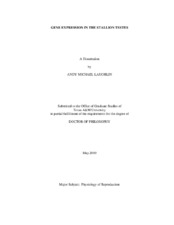| dc.description.abstract | Understanding the genes that regulate spermatogenesis and steroidogenesis in the testis is critical for enhancement of stallion fertility. Stallion testicular samples were used to identify candidate genes by cDNA microarrays that simultaneously assessed expression levels of 9132 genes. First, gene expression was compared between light (spermatogenically active) and dark (spermatogenically inactive) testis tissue of 1.5-year-old horses (n = 3). Ninety-three genes were differentially expressed (35 light specific, 58 dark specific) in matched paired samples. Second, gene expression was compared between testicular tissue of two mature stallions, one with normal quality semen (fertile) and one with poor quality semen (subfertile). A total of 233 genes were differentially expressed (122 in fertile tissue, 111 in subfertile tissue). Of these, phosphodiesterase 3B (PDE3B), steroidogenic acute regulatory (StAR) protein, and outer dense fiber of sperm tails 2 (ODF2) mRNAs, were localized and quantified by in situ hybridization (ISH) in mature stallions and/or in unilateral cryptorchids. ISH revealed differences (P < 0.05) among mature stallions (n = 10) for PDE3B (localized to seminiferous tubules) and StAR protein (localized to interstitial spaces) mRNAs. A positive correlation coefficient (r = .556, p = .025) was found between StAR protein mRNA and plasma concentration of testosterone. Additionally, both gene products were evaluated in 1-year-old (n = 3) and 3-year-old (n = 3) unilateral cryptorchid stallions. Expression of both PDE3B and StAR protein gene was significantly higher in mature, descended testes compared to mature, retained testes and the descended and retained testes of immature, cryptorchid stallions. StAR protein gene demonstrated significantly higher expression in immature retained testes compared to immature descended testes. A precision-cut tissue slice (PCTS) in vitro culture system was evaluated as a potential tool to study equine testes function. Testes from immature stallions (n = 3) were cut into slices (mean slice weight = 13.85 +/- 0.20 mg; mean slice thickness = 515.00 +/- 2.33 ?m) and exposed to medium containing ovine luteinizing hormone (oLH) at concentrations of 0, 5, 50 and 500 ng/ml for 6 h at 32 degrees C. Medium content of testosterone and estradiol was increased 500% and 120%, respectively, by addition of oLH versus that observed for the testis tissue slices treated with 0 ng oLH (control). An oLH concentration-dependent increase in StAR protein mRNA in tissue slices was detected by in situ hybridization; whereas, differences for PDE3B and ODF2 mRNAs were not observed. Collectively, these results demonstrate that the stallion is an excellent model for studying male fertility due to the initiation of spermatogenesis, frequency of cryptorchidism, and routine castration providing useful tissue to use for studying gene expression. | en |


